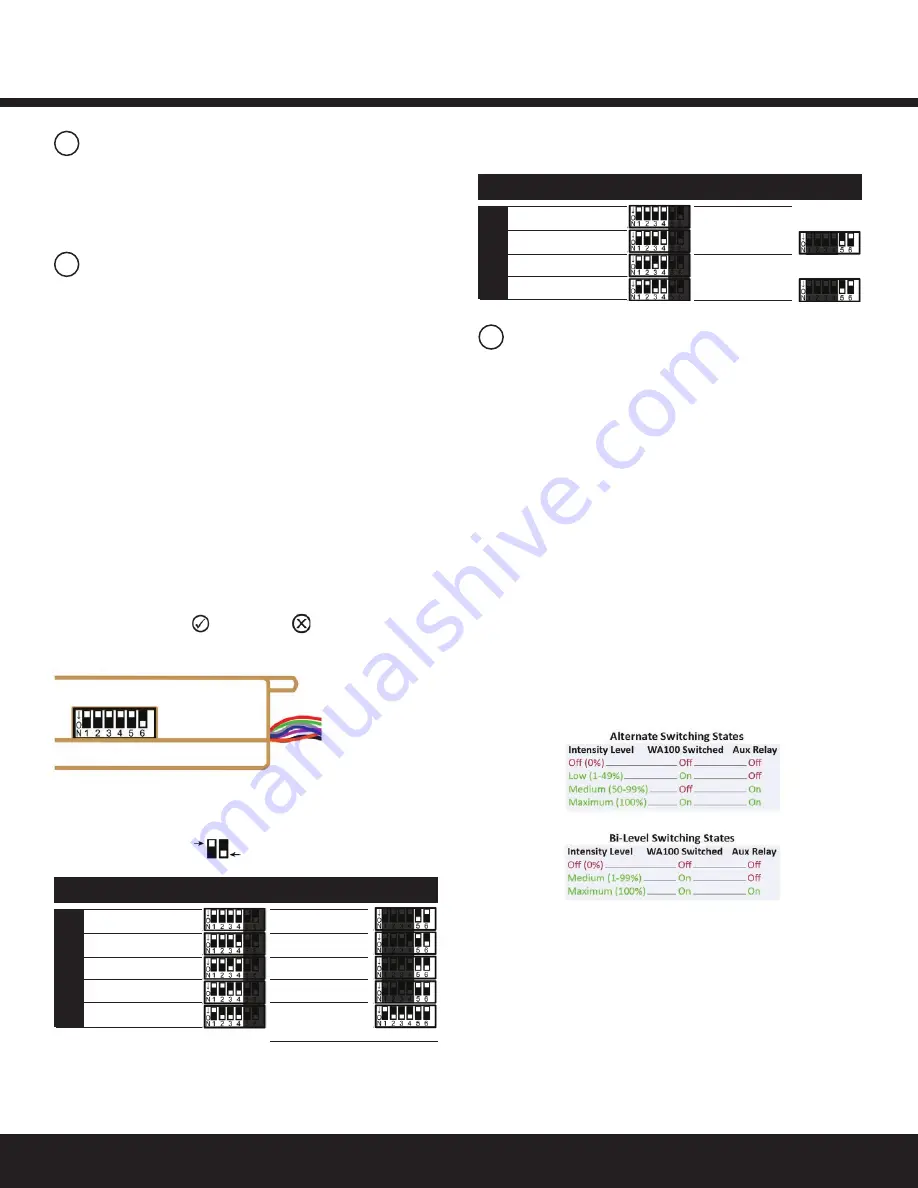
Installation Guide
Daintree
®
Networked Wireless Adapter (WA100-PM)
2
2
4
3
WA100-PM Model Variants
DIP Switch Mode descriptions
DIP Switch settings
The model number WA100 was the original version of the
adapter and is no longer sold. The
WA100-PM
model monitors
and measures the power consumption of the connected lighting
load. The WA100-PM reports power measurement data to DCS.
Figure 1:
DIP switch location
Figure 2:
DIP Switch Table — See DIP switch Mode
descriptions for information about each option.
DIP switch settings enable the WA100-PM to operate a
ppropriately for the type of lighting control it provides and
the type of device(s) to which it is connected and adapting
for wireless communication. Set DIP switches based only on
the
devices that are physically wired to the WA100-PM.
There are two primary adaptation modes to choose from as
determined by the DIP switch 1 setting.
• In Light Adapter Mode, the settings are for the type
of lighting control that is available on the connected
driver, and/or the sensor type(s) connected to the
WA100-PM.
• In the Switch Adapter Mode, settings are for the
connected switch type and whether the WA100-PM
is connected to a light.
Configure DIP switch settings only as shown in this instruction.
Incorrect switch settings will cause unexpected operation.
After you change DIP switch settings, you need to press the blue
Reset button for 3 seconds to reset the unit. Release the button
when the green Joined and red Error LEDs begin flashing.
Light Adapter Mode
Control Type
On/Off + 0-10V dimming:
provides On/Off control using its line
voltage Switched Load connection to the driver(s). It also provides
0-10V dimming control to the driver(s).
On/Off (no dimming):
provides On/Off control using its line
voltage Switched Load connection, and its low voltage digital
output to an external relay. Note, both outputs are switched at
the same time in this driver control mode.
Alternate:
provides On/Off switching for one driver load using its
line voltage Switched Load connection, and its low voltage digital
output to an external relay to switch a second driver load. This
allows lighting level control for no load (0%), one or the other of
the two loads, and both loads (100%). See Figure 13.
Bi-Level:
provides On/Off switching for one driver with two loads
using its line voltage Switched Load connection and low voltage
digital output an external relay to switch the second load. This
allows lighting level to control for no load (0%), partial load
(according to driver capability) or full load (100%). See Figure 12.
No Driver (sensors only):
provides wireless adaptation to
connected occupancy sensor and/or photosensor only. No
driver control.
Sensor
To provide wireless adaptation for sensors, set DIP switches 1, 5 &
6 according to the type(s) of sensors connected to the WA100-PM.
Range Extender
The WA100-PM joins the ZigBee network and acts only as a
wireless repeater to improve the wireless range and/ or reliability.
No lights or devices are connected to the WA100-PM.
Occupancy
Photosensor
Both
None
Range Extender*
no light, no sensor
*Valid only with firmware v2.6 or higher
On/Of f + 0-10V dimming
On/Of f (no dimming)
Alternate Switching
Bi-Level
No Driver (sensors only)
SensorSwitches 5 & 6
Mode
Driver Type Switches 1 to 4
DIP Switch Positions
Light Adapt
er
OFF
ON
Light + Switch
(driver & switch
are same type)
No Light
(switch only)
Dimming
On/Of f (no dimming)
Alternate Switch
Bi-Level
Light Output
Switches 5 & 6
Mode
Switch Type
Switches 1 to 4
Switch Adapter
Figure 2:
DIP Switch Table — See DIP switch Mode
descriptions for information about each option.



































